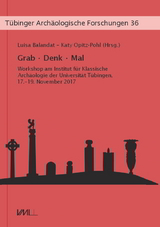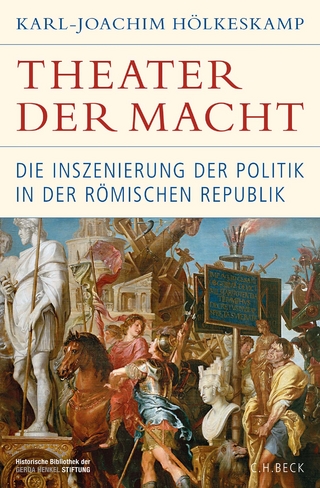Grab • Denk • Mal
Workshop am Institut für Klassische Archäologie der Universität Tübingen, 17.-19. November 2017
Seiten
2022
|
1., Aufl.
VML Vlg Marie Leidorf (Verlag)
978-3-89646-867-3 (ISBN)
VML Vlg Marie Leidorf (Verlag)
978-3-89646-867-3 (ISBN)
Die Errichtung von Grabdenkmälern ist die sichtbarste Form der Kanalisierung von Schmerz und Trauer über den Tod eines Menschen. In ihrer Sichtbarkeit kommt den Denkmälern aber auch eine wesentliche Bedeutung für die Konstruktion einer gemeinschaftlichen Erinnerung und damit für die Aushandlung gesellschaftlicher Werte und Normen zu. Inwiefern es sich bei den Grabmarkierungen um den in der Archäologie schon sprichwörtlichen ›Spiegel des Lebens‹ oder ein durch die Hinterbliebenen konstruiertes Bild des Toten handelt, war Thema einer im November 2017 in Tübingen veranstalteten Tagung. Das Spektrum der in diesem Band vorgelegten Beiträge reicht vom archaischen Westgriechenland über das klassische Attika, das hellenistische und römische Zentral- und Nordgriechenland bis hin zum kaiserzeitlichen Kleinasien sowie den weströmischen Provinzen. Es umfasst neben skulpturalen und architektonischen Denkmälern auch epigraphische Zeugnisse. Die Diversität der Materialbasis, die um einen vergleichenden Ausblick auf zeitgenössische Friedhöfe in Berlin und Umgebung erweitert wird, verdeutlicht dabei die zentrale Rolle gesellschaftlicher Konventionen bei der Gestaltung von Grabmarkierungen in unterschiedlichen Epochen und Räumen.
Building funerary monuments is the most visible way of channelling pain and grief at the death of a person. Due to their visibility, however, monuments also play a significant role in the construction of shared memory, and thereby in the negotiation of social values and norms. A conference held at Tübingen in November 2017 aimed to understand in how far grave markers could be read as a direct reflection of past realities [what archaeologists sometimes call a “mirror of life”], or rather represent a picture of the deceased constructed by the survivors. The contributions collected in this volume range from Archaic western Greece, and via Classical Attica, and Hellenistic and Roman central and Northern Greece, to Roman Asia Minor and the west Roman provinces. Alongside sculptures and architectural monuments it also includes epigraphic sources. This diversity of evidence, further extended through a comparative outlook on contemporary cemeteries in Berlin and surroundings, illustrates the central role of social conventions in the design of grave markers in the different periods and areas. Building funerary monuments is the most visible way of channelling pain and grief at the death of a person. Due to their visibility, however, monuments also play a significant role in the construction of shared memory, and thereby in the negotiation of social values and norms. A conference held at Tübingen in November 2017 aimed to understand in how far grave markers could be read as a direct reflection of past realities [what archaeologists sometimes call a “mirror of life”], or rather represent a picture of the deceased constructed by the survivors. The contributions collected in this volume range from Archaic western Greece, and via Classical Attica, and Hellenistic and Roman central and Northern Greece, to Roman Asia Minor and the west Roman provinces. Alongside sculptures and architectural monuments it also includes epigraphic sources. This diversity of evidence, further extended through a comparative outlook on contemporary cemeteries in Berlin and surroundings, illustrates the central role of social conventions in the design of grave markers in the different periods and areas.
Building funerary monuments is the most visible way of channelling pain and grief at the death of a person. Due to their visibility, however, monuments also play a significant role in the construction of shared memory, and thereby in the negotiation of social values and norms. A conference held at Tübingen in November 2017 aimed to understand in how far grave markers could be read as a direct reflection of past realities [what archaeologists sometimes call a “mirror of life”], or rather represent a picture of the deceased constructed by the survivors. The contributions collected in this volume range from Archaic western Greece, and via Classical Attica, and Hellenistic and Roman central and Northern Greece, to Roman Asia Minor and the west Roman provinces. Alongside sculptures and architectural monuments it also includes epigraphic sources. This diversity of evidence, further extended through a comparative outlook on contemporary cemeteries in Berlin and surroundings, illustrates the central role of social conventions in the design of grave markers in the different periods and areas. Building funerary monuments is the most visible way of channelling pain and grief at the death of a person. Due to their visibility, however, monuments also play a significant role in the construction of shared memory, and thereby in the negotiation of social values and norms. A conference held at Tübingen in November 2017 aimed to understand in how far grave markers could be read as a direct reflection of past realities [what archaeologists sometimes call a “mirror of life”], or rather represent a picture of the deceased constructed by the survivors. The contributions collected in this volume range from Archaic western Greece, and via Classical Attica, and Hellenistic and Roman central and Northern Greece, to Roman Asia Minor and the west Roman provinces. Alongside sculptures and architectural monuments it also includes epigraphic sources. This diversity of evidence, further extended through a comparative outlook on contemporary cemeteries in Berlin and surroundings, illustrates the central role of social conventions in the design of grave markers in the different periods and areas.
| Erscheinungsdatum | 14.09.2022 |
|---|---|
| Reihe/Serie | Tübinger Archäologische Forschungen ; 35 |
| Verlagsort | Rahden |
| Sprache | englisch; deutsch |
| Maße | 210 x 297 mm |
| Gewicht | 1130 g |
| Einbandart | gebunden |
| Themenwelt | Geschichte ► Allgemeine Geschichte ► Altertum / Antike |
| Schlagworte | Frau • Grabbau • Gräberfeld • Griechen • Literalität • Ritual • Römische Provinzen |
| ISBN-10 | 3-89646-867-7 / 3896468677 |
| ISBN-13 | 978-3-89646-867-3 / 9783896468673 |
| Zustand | Neuware |
| Haben Sie eine Frage zum Produkt? |
Mehr entdecken
aus dem Bereich
aus dem Bereich
die Inszenierung der Politik in der römischen Republik
Buch | Hardcover (2023)
C.H.Beck (Verlag)
CHF 67,20
Buch | Hardcover (2024)
Klett-Cotta (Verlag)
CHF 69,95




